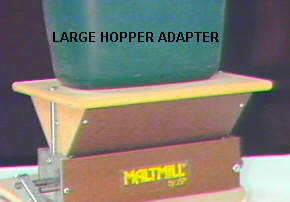MALTMILL ®
Jack Schmidling Productions, Inc.18016 Church Road ~ Marengo IL 60152
Please be advised that a fire totally destroyed our facilities and that we are no longer doing business. This page is maintained for informational purposes only.
| Reviews | Ordering Info | Application Notes |
| BAREBONES MM | Beer Page | HOME PAGE |
![[MALTMILL photo]](maltmill.jpg)
The MALTMILL is an authentic roller mill that makes it possible for homebrewers to turn out textbook quality milled grain. It crushes the malt, leaving the husk intact while producing a minimum of flour. Not one grain can get through without being properly milled. It does exactly what a malt mill is supposed to do.
Anyone who uses whole grains quickly realizes that makeshift grinders and food processors are all but totally unsuited for milling malt. They create vast amounts of flour that make clear beer virtually impossible. They leave large amounts of grain untouched or merely broken. They pulverize or shred the husks, which severely limits the quality of the filter bed when sparging. They are only used because, until now, nothing else has been available that fits the budget of even the affluent home brewer.
The MALTMILL will process a pound of grain in less than 15 seconds and enough for a five gallon batch in under five minutes with the hand crank. When motorized, it can crush at a rate in excess of 1000 lbs per hour. At 400 RPM, it takes 3.3 seconds to crush one pound. It is designed to sit on top of a bucket or mash tun so that the milled product falls in and any dust created is contained. It can also be bolted or clamped to a work table for more stable or permanent operation.
The MALTMILL is provided with a nominal spacing of .045" between the rollers. This produces an excellent crush on all commonly used malt. An adjustable version is available for those who perceive the need for additional flexibility . The roller journals ride in oil-impregnated bronze bearings, pressed into aluminum castings. A coarse textured surface on the rollers prevents the grain from slipping and is the key to providing an efficient mill at far less cost then conventional multiple stage roller mills.
The MALTMILL relies on the grain to drive the passive roller and the above cited throughput is based on this configuration. For additional efficiency, in high volume operations, a Gear Drive Option (GDO) is available to drive the passive roller directly from the driven roller through precision-ground, steel gears. These gears have different numbers of teeth, to provide a differential rotational rate for the rollers.
The standard rollers are fabricated from cold rolled steel. The crushing surface is 10" long and 1-1/2" in diameter, the largest in the home brew industry. Unlike some competing mills using hollow tubes, the MALTMILL rollers are turned down from solid bar stock. The bearing journals and drive shaft are integral to the roller and offer the ultimate in reliability. We also offer case hardened rollers for the high volume commercial user to eliminate the need to return the rollers for re-knurling.

T
We don't claim the LHA is rocket science, we just did it for the person without the time or inclination to do it.
For a picture of an LHA in action at a real megabrewing company, Click Here
I don't recall if this was Coors or another brewer in Finland but you will get the idea.
We do not sell a motorized mill. In fact, we are so paranoid about being sued and driven into poverty, that we do not even discuss the subject much less give recommendations on how to do it. However, we are more than happy to pass along information provided by happy customers telling us how they motorized their mills. One of the most informative pieces I have seen on the subject can be seen on Mike Dixon's web site and he has given us his kind permission to publlish the link here....... Motorizing a mill..... Thanks Mike.
![[MALTMILL photo]](bb.jpg)